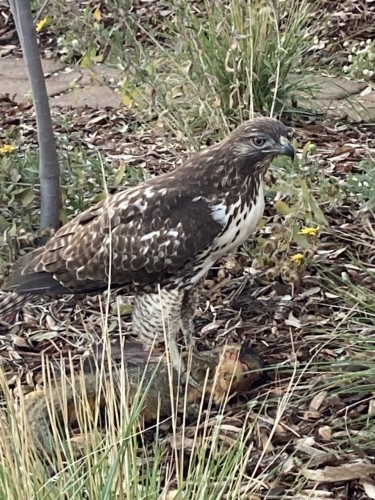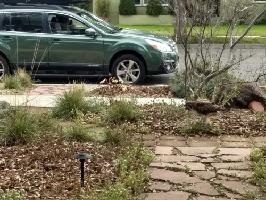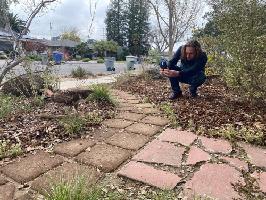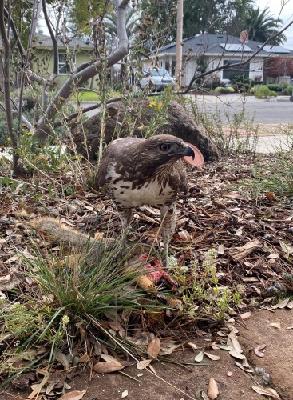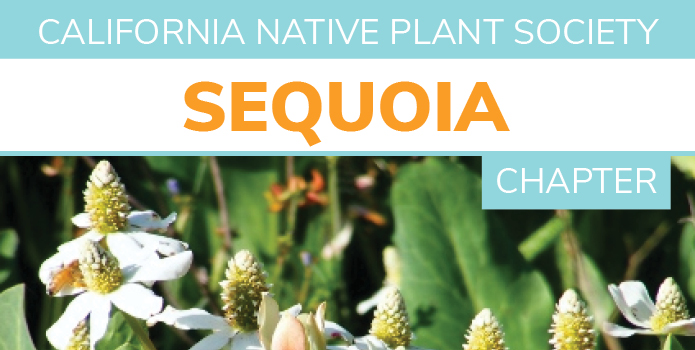 |
January 2022
CONTENT |
||||
President Reflections of 2021 and Looking Forward to the New Year--Reagen O'Leary Last year was a time of change for the Sequoia Chapter, hopefully this year will be a time of new endeavors. In 2021, we filled the chapter’s leadership roles with native plant enthusiasts ready to work together to meet our common goal and spread the word on how awesome California native plants are!
When I stepped up as president, I immediately made a list of ideas and goals for the chapter. Two of my biggest goals were 1) to work on creating a Sequoia Chapter logo that we could add to merchandise (another source of income for the chapter), and 2) establish a native plant garden that would have high public visibility. I’m so excited to share with you that we are in the process of meeting both goals!
Our future logo will include three wildflowers that represent the counties we serve: for Madera, Shuteye Peak fawn lily (Erythronium pluriflorum), a county endemic; for Fresno, Eastwood's baby blue-eyes (Nemophila pulchella); and for Kings, Parry's mallow (Eremelache parryi). Once this logo is complete, we will highlight these species and the artist, Emma Rose Fryer (a CNPS member and local botanist), in the newsletter. We are currently collaborating with Fresno Chaffee Zoo on potentially establishing a California native plant garden. We are in the planning stages and it’s not official yet. Stay tuned! |
||||
Fall Planting--Chris Velez (Photos Courtesy of Intermountain Nursery) Fall is a great time for planting California native plants. The shorter days and the cooler weather really help to establish strong root development in the spring. By planting in the fall, you are encouraging the roots system to develop before they start their vegetative growth cycle. This helps the plant naturalize in the garden and have a better success rate through our long hot summers. Some of our California native plants like purple needle grass (Stipa pulchra) and silver bush lupine (Lupinus albifrons) have adapted to our short seasons and only grow in these cooler months. Drainage: • Make sure your soils drain. We recommend digging your holes before you are ready to plant. Your holes should be about as deep as the root ball. A 1 gallon pot is 7” x 6.5” and a 5 gallon pot is 12” x 10.5”. Square holes are showing to be very effective in helping to establish plants. In some restoration cases, I have used a jackhammer to penetrate and help roots get down in those harder soils, but it is better to match your plants to the soils than have to disturb too much of the lower soil horizons. • Next, fill each hole with water and make sure it drains out by the next day. This is also a great way to help chose what is appropriate for that area. If the hole drains slow you may not want to put a plant that does not like that kind of moisture. Knowing this before you get to the nursery can help get you a plant that may work better in those conditions. Watering In Plants:
• Water with a five gallon bucket after you get done planting or with a water hose, making sure not to cause any erosion. Be sure to knock down any water wells you may have made to retain water, these can cause the plants to hold too much water as they get older and erosion can cover up the crown causing it to smother and die. If you are using drip, make sure that the holes are pre-irrigated or your plant may not get evenly watered. After plants have been properly watered, you can rely on a drip irrigation to do the rest. Watering once a week for a few hours should suffice in most situations; but, in gardening, it always depends. So check your plants the first few weeks to make sure they do indeed need that water. A great way to do that is to check with a finger. If it is dry to your finger nail don’t water. Overwatering and poor drainage is the number one killer of plants. Mulching: • There are many different methods of mulching for our native plants. One of the best ways we have found is using hard wood chip, such as a stone fruit hard wood shredded mulch. It lasts a long time in the garden and helps retain the moisture to the plants. We recommend a 4” layer, making sure that you don’t pile it too high by covering the crown or you could kill your plant. You can also resource local chips from your tree trimmer and arborist, but make sure there is no diseased material. We hope this helps you and that you have a wonderful season establishing your California native plant garden.
|
||||
China Creek Report - November 2021--Warren Shaw (Photos by Warren Shaw) The day began with some confusion due, apparently, to mixed messages about the start time. For the record, work parties in November, January, and February traditionally started at 9:00AM, with a hiatus in December.
It was a foggy hazy day but not unpleasantly cold, and we had a great turnout of regulars and students from Pacific U, who all went to work with a will. The planting was finished in plenty of time for our traditional annual “Thank you” lunch at the Blossom Trail Café’s patio, where Volunteer Coordinator, Chris Kurowski, thanked everybody for helping to make 2021 a great year for the Park. The next work party will be on February 19, 2022, on Saturday from 9am-12pm. Please note “winter” start time. We’ll be getting to some of those pesky YST plants, doing some gate work, checking on our seedlings, and whatever else needs to be done to get the “spring semester” off to a good start. We wish all who participate in the China Creek Project Peace, Love, and Joy for the New Year, and, once again, Thank You |
||||
| The China Creek work party days for the winter and spring semester 2022 are as follows:
----February 19---- 8am-12pm ----March 5---- 8am-12pm ----March 19---- 8am-12pm ----April 9---- 8am-12pm ----April 23---- 8am-12pm ----May 14---- 8am-12pm ----June 4---- 8am-12pm ----June 18---- 8am-12pm |
||||
Home School at China Creek--Warren Shaw (Photos by Coordinator Ger) On December 3, 2021, the home-school group who meet regularly at the Park came prepared to help us (as did the climate) by planting some Valley oaks in our “reforestation” project zone in the northwest corner of the Park.
Next, we helped the kids choose spots for their three trees near the trail, and got them started digging. The kids vary a lot in size, strength, and attention span, but most got a chance to help at least a little with the digging, planting and marking. They named their trees, and we suggested it would be good to make, and post, signs by them. Finally, we pointed out the massive old tree near station 13 on the trail (about 5 feet in diameter at ground level, close to 100 feet tall, and probably at least 200 years old) and told them it was possible that their trees would someday reach that size, and that their grandchildren might be able to visit them. Some seemed impressed. The kids had a good time, and the participating adults felt good, too. It was a great day for California native plants; a great use of the Park and at least a little something for the future.
|
||||
China Creek Beaver Dam Problem--Warren Shaw (Photo by Warren Shaw) Recently we had noticed that the south pond at the Park was quite low. Concerned because of the upcoming water bird nesting season, we investigated, and were surprised to find the water high and the inlet clogged with sticks cobbles and other debris. Then we noticed the sound of rushing water downstream, and though we couldn’t see it because of thick brush along the bank, we concluded beavers had dammed the creek and plugged the inlet because it constituted a “leak” in their pond.
|
||||
An Interesting End to 2021--Reagen O'Leary (Top photo by Robb Tibstra and all additional photos by Reagen O'Leary) As the year was coming to an end, the O’Leary’s urban native plant garden had a surprise visitor for three consecutive days – a juvenile red-tailed hawk! Right before winter break, our friend and Sequoia Chapter member Robb Tibstra dropped our son Cael off from school and noticed that a hawk was eating a fox squirrel right next to the sidewalk. After spending at least a half hour slowly getting closer, they realized that the bird did not care; it never flushed or spooked, and continued to eat. So, Robb and Cael got all sorts of photos and videos of this exciting visitor to share with family and friends. |
||||
Calendar of Upcoming Events--Debbie DiNoto CNPS (our parent organization), this page has several links for webinars, etc., for the month of January and February. Converting Your Lawn to Meadow, Saturday, February 5, 2022, 10 – 11:00 AM -- Fresno County Master Gardener Classes In this class you will learn how to convert your traditional lawn into a meadow that over time will attract pollinators, use less water and require less maintenance and cost. Native grasses and wildflowers will be discussed. Restore some of the native beauty of the Central Valley to your home garden. Learn from Master Gardener Tim about how to save water.
The Chino Basin Water Conservation District Offers several workshops featuring native plants and how to transform your landscape. Landscape Transformation Basics - Online Workshop, February 17, 2022, 6:00 PM -- 8:30 PM California Native Garden Design - Online Workshop, March 5, 2022, 9:00 AM -- 12:00 PM Virtual Education Series February/March 2022 -- New Directions in the American Landscape This winter series is geared toward landscape professions, non-professionals or both. Co-sponsored by Wild Ones—Native Plants, Natural Landscapes, American Horticultural Society and the Lady Bird Johnson Wildflower Center. Details: New Directions in American Landscapes Bring Back the Natives Garden Tour California Native Plant Landscaper Certificate Program -- Theodore Payne Foundation The California Native Plant Landscaper Certificate Program is a vocational training program designed for landscape professionals. Developed by top California native plant experts, it gives students the tools they need to successfully manage CA native plant and CA-friendly gardens. During the pilot phase of this program, the entire nine class curriculum is FREE for professional landscapers and gardeners. At the end of the course, participants will receive a certificate of completion and learn tools for using their knowledge and skills to promote their business. (ESPAÑOL) This pilot program is offered by the Theodore Payne Foundation in partnership with California Native Plant Society, and the US Green Building Council Los Angeles. This project is generously supported by the Los Angeles Department of Water and Power Community Partnerships Program. If you are interested in participating in this free program, please fill out this short survey. Contact pros@theodorepayne.org if you have questions. Theodore Payne Foundation Native Plant Garden Tour, April 23 and April 24, 2022 Spotlighting 30+ gardens across the city, this two-day journey will bring together the plants and people that make Southern California one of the most unique and biodiverse places on the planet. Highlights include 10+ new gardens, a new stylized tour guide filled with vivid stories and interviews, and an after-party at L.A. State Historic Park. Each ticket includes admission for a single visitor to all gardens across both days, admission to the after-party, a printed color guide with addresses and driving directions. The tour is self-guided, so you can make your own itinerary and go at your own pace. Tickets and tour guides will be mailed starting in early March. Children under 16 do not require a ticket. Former Garden Tours are on the internet for your viewing pleasure (I highly recommend them!). Info and Past Garden Tours. (The 2019 Garden 4 is a personal favorite) California Botanic Garden
|
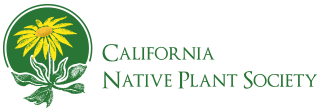 |
|
|
|
CNPS Statewide Website | Sequoia Chapter Website |
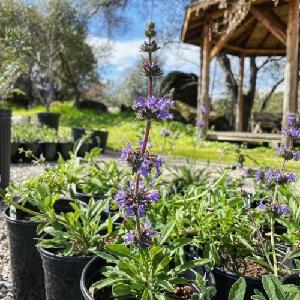 • After making sure that your holes drain, you are going to want to match the plants you hope to establish with the drainage in the holes. If your soils are fast draining, make sure you get plants like ceanothus, sage, and manzanita to go into those soils. Make sure that when you put your plants in the ground that they sit soil level with soil level. I don't tend to add to much in the form of soil amendments with natives plants unless it really calls for it.
• After making sure that your holes drain, you are going to want to match the plants you hope to establish with the drainage in the holes. If your soils are fast draining, make sure you get plants like ceanothus, sage, and manzanita to go into those soils. Make sure that when you put your plants in the ground that they sit soil level with soil level. I don't tend to add to much in the form of soil amendments with natives plants unless it really calls for it.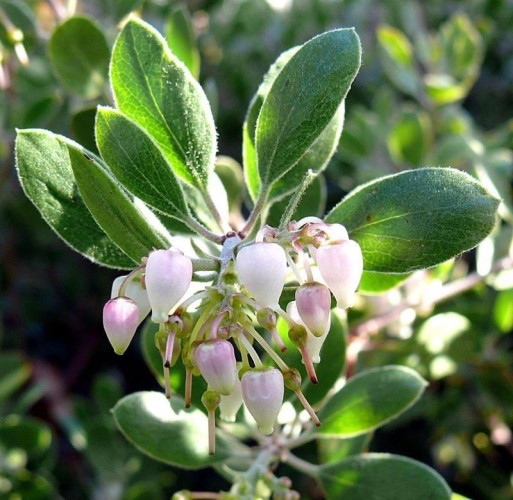
 In any case, we soon got organized with our big project of the day, planting 60 Valley oak seedlings to “reforest” the northwest corner of the park, which had previously been fenced for grazing. In addition to digging holes for, planting, and watering all those seedlings, we removed a lot of old yellow starthistle plants (YST). (There are a lot left; something to look forward to in 2022). Special thanks to Ann, who brought and operated the “water truck.”
In any case, we soon got organized with our big project of the day, planting 60 Valley oak seedlings to “reforest” the northwest corner of the park, which had previously been fenced for grazing. In addition to digging holes for, planting, and watering all those seedlings, we removed a lot of old yellow starthistle plants (YST). (There are a lot left; something to look forward to in 2022). Special thanks to Ann, who brought and operated the “water truck.”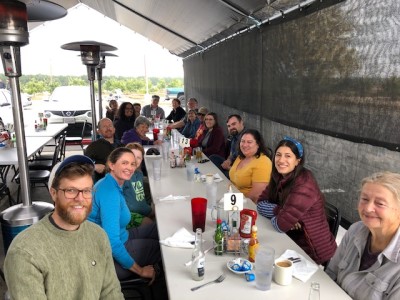
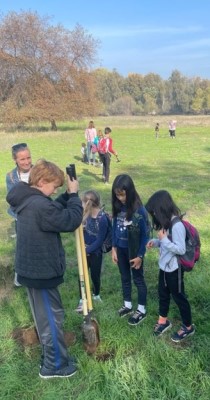 First, we talked a little about where oaks come from (thanks to Kathy, we had a few acorns to show) and how we would do the planting. Then, we set out with shovels and posthole diggers to the planting area. Since the nearby pond is dry, we had to dip water out from standing water near the road and haul it to the site; an awkward and messy procedure, but we managed.
First, we talked a little about where oaks come from (thanks to Kathy, we had a few acorns to show) and how we would do the planting. Then, we set out with shovels and posthole diggers to the planting area. Since the nearby pond is dry, we had to dip water out from standing water near the road and haul it to the site; an awkward and messy procedure, but we managed.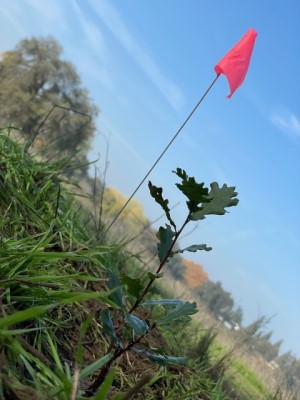
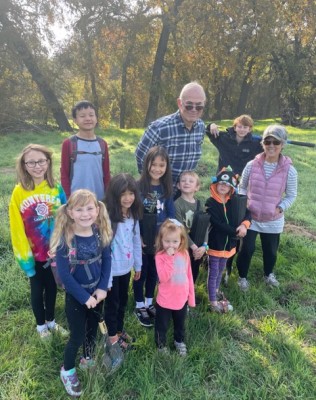
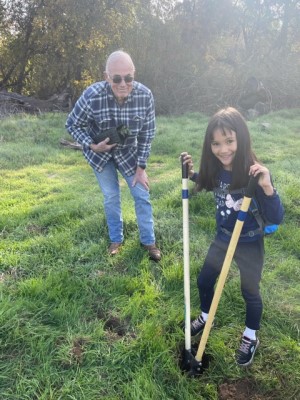
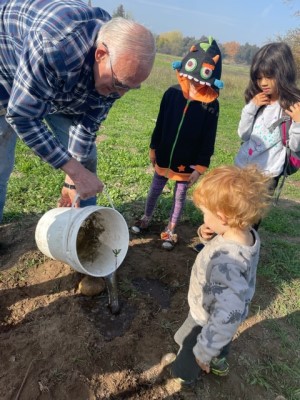
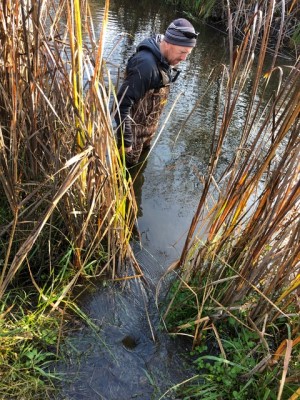 Fortunately, Gavin O’Leary owns waders and, as a fly fisherman, is not afraid of water. First, he climbed into the standpipe and pulled out as much as he could from that end, which helped a little. Then, he waded into the creek and, with his bare hands, pulled a clot of sticks, cobbles, mud and fibrous tule roots out of the inlet, creating a rush of water that made a small whirlpool and a “hole” in the water. This was a good start. We know, however, that beavers are famously persistent, that they hate leaks in their home ponds, and that we will have to be equally persistent to keep the water flowing to the pond. We’re planning to try positioning one of our remesh tree cages at the inlet in hopes of slowing the beavers down in their efforts. This is likely to be an ongoing challenge for us, but with any kind of luck, we should be able to keep enough water in the pond for the birds without discouraging the beavers too much.
Fortunately, Gavin O’Leary owns waders and, as a fly fisherman, is not afraid of water. First, he climbed into the standpipe and pulled out as much as he could from that end, which helped a little. Then, he waded into the creek and, with his bare hands, pulled a clot of sticks, cobbles, mud and fibrous tule roots out of the inlet, creating a rush of water that made a small whirlpool and a “hole” in the water. This was a good start. We know, however, that beavers are famously persistent, that they hate leaks in their home ponds, and that we will have to be equally persistent to keep the water flowing to the pond. We’re planning to try positioning one of our remesh tree cages at the inlet in hopes of slowing the beavers down in their efforts. This is likely to be an ongoing challenge for us, but with any kind of luck, we should be able to keep enough water in the pond for the birds without discouraging the beavers too much.